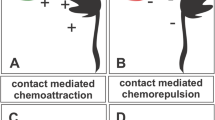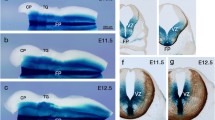Abstract
Axons of the corpus callosum (CC), the white matter tract that connects the left and right hemispheres of the brain, receive instruction from a number of chemoattractant and chemorepulsant cues during their initial navigation towards and across the midline. While it has long been known that the CC is malformed in the absence of Myristoylated alanine-rich C-kinase substrate (MARCKS), evidence for a direct role of MARCKS in axon navigation has been lacking. Here, we show that MARCKS is necessary for Netrin-1 (NTN1) signaling through the DCC receptor, which is critical for axon guidance decisions. Marcks null (Marcks−/−) neurons fail to respond to exogenous NTN1 and are deficient in markers of DCC activation. Without MARCKS, the subcellular distributions of two critical mediators of NTN1-DCC signaling, the tyrosine kinases PTK2 and SRC, are disrupted. Together, this work establishes a novel role for MARCKS in axon dynamics and highlights the necessity of MARCKS as an organizer of DCC signaling at the membrane.






Similar content being viewed by others
References
Gobius I, Richards L (2011) Creating connections in the developing brain: mechanisms regulating corpus callosum development. Colloquium Ser Dev Brain 2(1):1–48
Serafini T, Colamarino SA, Leonardo ED, Wang H, Beddington R, Skarnes WC, Tessier-Lavigne M (1996) Netrin-1 is required for commissural axon guidance in the developing vertebrate nervous system. Cell 87(6):1001–1014
Fazeli A, Dickinson SL, Hermiston ML, Tighe RV, Steen RG, Small CG, Stoeckli ET, Keino-Masu K et al (1997) Phenotype of mice lacking functional deleted in colorectal cancer (Dcc) gene. Nature 386(6627):796–804
Varadarajan SG, Kong JH, Phan KD, Kao TJ, Panaitof SC, Cardin J, Eltzschig H, Kania A et al (2017) Netrin1 produced by neural progenitors, not floor plate cells, is required for axon guidance in the spinal cord. Neuron 94(4):790–799.e3
Dominici C, Moreno-Bravo JA, Puiggros SR, Rappeneau Q, Rama N, Vieugue P, Bernet A, Mehlen P et al (2017) Floor-plate-derived netrin-1 is dispensable for commissural axon guidance. Nature 545(7654):350–354
de la Torre JR, Höpker VH, Ming GL, Poo MM, Tessier-Lavigne M, Hemmati-Brivanlou A, Holt CE (1997) Turning of retinal growth cones in a netrin-1 gradient mediated by the netrin receptor DCC. Neuron 19(6):1211–1224
Manitt C, Nikolakopoulou AM, Almario DR, Nguyen SA, Cohen-Cory S (2009) Netrin participates in the development of retinotectal synaptic connectivity by modulating axon arborization and synapse formation in the developing brain. J Neurosci 29(36):11065–11077
Dent EW, Barnes AM, Tang F, Kalil K (2004) Netrin-1 and semaphorin 3A promote or inhibit cortical axon branching, respectively, by reorganization of the cytoskeleton. J Neurosci 24(12):3002–3012
Tang F, Kalil K (2005) Netrin-1 induces axon branching in developing cortical neurons by frequency-dependent calcium signaling pathways. J Neurosci 25(28):6702–6715
Hong K, Hinck L, Nishiyama M, Poo MM, Tessier-Lavigne M, Stein E (1999) A ligand-gated association between cytoplasmic domains of UNC5 and DCC family receptors converts netrin-induced growth cone attraction to repulsion. Cell 97(7):927–941
Li W, Lee J, Vikis HG, Lee SH, Liu G, Aurandt J, Shen TL, Fearon ER et al (2004) Activation of FAK and Src are receptor-proximal events required for netrin signaling. Nat Neurosci 7(11):1213–1221
Moore SW, Zhang X, Lynch CD, Sheetz MP (2012) Netrin-1 attracts axons through FAK-dependent mechanotransduction. J Neurosci 32(34):11574–11585
Zhou J, Bronowska A, le Coq J, Lietha D, Gräter F (2015) Allosteric regulation of focal adhesion kinase by PIP(2) and ATP. Biophys J 108(3):698–705
Meriane M, Tcherkezian J, Webber CA, Danek EI, Triki I, McFarlane S, Bloch-Gallego E, Lamarche-Vane N (2004) Phosphorylation of DCC by Fyn mediates Netrin-1 signaling in growth cone guidance. J Cell Biol 167(4):687–698
Shekarabi M, Moore SW, Tritsch NX, Morris SJ, Bouchard JF, Kennedy TE (2005) Deleted in colorectal cancer binding netrin-1 mediates cell substrate adhesion and recruits Cdc42, Rac1, Pak1, and N-WASP into an intracellular signaling complex that promotes growth cone expansion. J Neurosci 25(12):3132–3141
Gambhir A, Hangyás-Mihályné G, Zaitseva I, Cafiso DS, Wang J, Murray D, Pentyala SN, Smith SO et al (2004) Electrostatic sequestration of PIP2 on phospholipid membranes by basic/aromatic regions of proteins. Biophys J 86(4):2188–2207
Yamaguchi H et al (2009) MARCKS regulates lamellipodia formation induced by IGI-I via association with PIP2 and beta-actin at membrane microdomains. J Cell Physiol 220(3):748–755
Weimer JM, Yokota Y, Stanco A, Stumpo DJ, Blackshear PJ, Anton ES (2009) MARCKS modulates radial progenitor placement, proliferation and organization in the developing cerebral cortex. Development 136(17):2965–2975
Stumpo DJ, Bock CB, Tuttle JS, Blackshear PJ (1995) MARCKS deficiency in mice leads to abnormal brain development and perinatal death. Proc Natl Acad Sci U S A 92(4):944–948
Shu T, Richards LJ (2001) Cortical axon guidance by the glial wedge during the development of the corpus callosum. J Neurosci 21(8):2749–2758
Tran TS, Phelps PE (2000) Axons crossing in the ventral commissure express L1 and GAD65 in the developing rat spinal cord. Dev Neurosci 22(3):228–236
Muthusamy N, Sommerville LJ, Moeser AJ, Stumpo DJ, Sannes P, Adler K, Blackshear PJ, Weimer JM et al (2015) MARCKS-dependent mucin clearance and lipid metabolism in ependymal cells are required for maintenance of forebrain homeostasis during aging. Aging Cell 14(5):764–773
Goebbels S, Bormuth I, Bode U, Hermanson O, Schwab MH, Nave KA (2006) Genetic targeting of principal neurons in neocortex and hippocampus of NEX-Cre mice. Genesis 44(12):611–621
Boisvert FM et al (2012) A quantitative spatial proteomics analysis of proteome turnover in human cells. Mol Cell Proteomics 11(3):M111 011429
Zhuo L, Theis M, Alvarez-Maya I, Brenner M, Willecke K, Messing A (2001) hGFAP-cre transgenic mice for manipulation of glial and neuronal function in vivo. Genesis 31(2):85–94
Roux KJ, Kim DI, Raida M, Burke B (2012) A promiscuous biotin ligase fusion protein identifies proximal and interacting proteins in mammalian cells. J Cell Biol 196(6):801–810
Zhu Y, Romero MI, Ghosh P, Ye Z, Charnay P, Rushing EJ, Marth JD, Parada LF (2001) Ablation of NF1 function in neurons induces abnormal development of cerebral cortex and reactive gliosis in the brain. Genes Dev 15(7):859–876
Roux KJ, Kim DI, Burke B (2013) BioID: a screen for protein-protein interactions. Curr Protoc Protein Sci 74:Unit 19 23
Ren XR, Ming GL, Xie Y, Hong Y, Sun DM, Zhao ZQ, Feng Z, Wang Q et al (2004) Focal adhesion kinase in netrin-1 signaling. Nat Neurosci 7(11):1204–1212
Patwardhan P, Resh MD (2010) Myristoylation and membrane binding regulate c-Src stability and kinase activity. Mol Cell Biol 30(17):4094–4107
Li X, Saint-Cyr-Proulx E, Aktories K, Lamarche-Vane N (2002) Rac1 and Cdc42 but not RhoA or Rho kinase activities are required for neurite outgrowth induced by the Netrin-1 receptor DCC (deleted in colorectal cancer) in N1E-115 neuroblastoma cells. J Biol Chem 277(17):15207–15214
Llambi F, Causeret F, Bloch-Gallego E, Mehlen P (2001) Netrin-1 acts as a survival factor via its receptors UNC5H and DCC. EMBO J 20(11):2715–2722
Brudvig JJ, Weimer JM (2015) X MARCKS the spot: myristoylated alanine-rich C kinase substrate in neuronal function and disease. Front Cell Neurosci 9:407
Guan JL (1997) Role of focal adhesion kinase in integrin signaling. Int J Biochem Cell Biol 29(8–9):1085–1096
Sheats MK, Pescosolido KC, Hefner EM, Sung EJ, Adler KB, Jones SL (2014) Myristoylated alanine rich C kinase substrate (MARCKS) is essential to beta2-integrin dependent responses of equine neutrophils. Vet Immunol Immunopathol 160(3–4):167–176
Gatlin JC, Estrada-Bernal A, Sanford SD, Pfenninger KH (2006) Myristoylated, alanine-rich C-kinase substrate phosphorylation regulates growth cone adhesion and pathfinding. Mol Biol Cell 17(12):5115–5130
Franco M, Tamagnone L (2008) Tyrosine phosphorylation in semaphorin signalling: shifting into overdrive. EMBO Rep 9(9):865–871
Trovo L et al (2013) Low hippocampal PI(4,5)P(2) contributes to reduced cognition in old mice as a result of loss of MARCKS. Nat Neurosci 16(4):449–455
Swierczynski SL, Siddhanti SR, Tuttle JS, Blackshear PJ (1996) Nonmyristoylated MARCKS complements some but not all of the developmental defects associated with MARCKS deficiency in mice. Dev Biol 179(1):135–147
Scarlett CO, Blackshear PJ (2003) Neuroanatomical development in the absence of PKC phosphorylation of the myristoylated alanine-rich C-kinase substrate (MARCKS) protein. Brain Res Dev Brain Res 144(1):25–42
Swierczynski SL, Blackshear PJ (1995) Membrane association of the myristoylated alanine-rich C kinase substrate (MARCKS) protein. Mutational analysis provides evidence for complex interactions. J Biol Chem 270(22):13436–13445
Podjaski C, Alvarez JI, Bourbonniere L, Larouche S, Terouz S, Bin JM, Lécuyer MA, Saint-Laurent O et al (2015) Netrin 1 regulates blood-brain barrier function and neuroinflammation. Brain 138(Pt 6):1598–1612
Xie Z, Enkhjargal B, Reis C, Huang L, Wan W, Tang J, Cheng Y, Zhang JH (2017) Netrin-1 preserves blood-brain barrier integrity through deleted in colorectal cancer/focal adhesion kinase/RhoA signaling pathway following subarachnoid hemorrhage in rats. J Am Heart Assoc 6(5):e005198
Mehlen P, Rabizadeh S, Snipas SJ, Assa-Munt N, Salvesen GS, Bredesen DE (1998) The DCC gene product induces apoptosis by a mechanism requiring receptor proteolysis. Nature 395(6704):801–804
Walters MC, Fiering S, Bouhassira EE, Scalzo D, Goeke S, Magis W, Garrick D, Whitelaw E et al (1999) The chicken beta-globin 5'HS4 boundary element blocks enhancer-mediated suppression of silencing. Mol Cell Biol 19(5):3714–3726
Matsuda T, Cepko CL (2007) Controlled expression of transgenes introduced by in vivo electroporation. Proc Natl Acad Sci U S A 104(3):1027–1032
Pear WS, Nolan GP, Scott ML, Baltimore D (1993) Production of high-titer helper-free retroviruses by transient transfection. Proc Natl Acad Sci U S A 90(18):8392–8396
Birendra K et al (2017) VRK2A is an A-type lamin-dependent nuclear envelope kinase that phosphorylates BAF. Mol Biol Cell 28(17):2241–2250
Bindea G, Mlecnik B, Hackl H, Charoentong P, Tosolini M, Kirilovsky A, Fridman WH, Pagès F et al (2009) ClueGO: a Cytoscape plug-in to decipher functionally grouped gene ontology and pathway annotation networks. Bioinformatics 25(8):1091–1093
Durkin ME et al (2013) Isolation of mouse embryo fibroblasts. Bio Protoc 3(18)
Polleux F, Ghosh A (2002) The slice overlay assay: a versatile tool to study the influence of extracellular signals on neuronal development. Sci STKE 2002(136):pl9
Holden P, Horton WA (2009) Crude subcellular fractionation of cultured mammalian cell lines. BMC Res Notes 2:243
Mahmood T, Yang PC (2012) Western blot: technique, theory, and trouble shooting. N Am J Med Sci 4(9):429–434
Acknowledgements
This work was supported by a Department of Defense National Defense Science & Engineering Graduate (NDSEG) fellowship for J.J.B., a University of South Dakota Center for Brain and Behavior Research (CBBRe) trainee research grant for J.J.B., the Intramural Research Program of the National Institute of Environmental Health Sciences, National Institutes of Health (D.J.S. and P.J.B.), and a grant from the National Institutes of Health to J.M.W. (R01NS082283). This work also received support from the Sanford Research Imaging Core and the Sanford Research Protein Biochemistry Core, both within the Sanford Research Center for Pediatric Research (National Institutes of Health P20GM103620).
Author information
Authors and Affiliations
Corresponding author
Ethics declarations
Animal protocols were approved by the Sanford Research Institutional Animal Care and Use Committee (USDA License 46-R-0009) with all procedures carried out in strict accordance with National Institutes of Health guidelines and the Sanford Research Institutional Animal Care and Use Committee guidelines.
Conflict of Interest
The authors declare that they have no conflict of interest.
Electronic supplementary material
Online Resource 1
(DOCX 4496 kb)
Online Resource 2
(DOCX 1391 kb)
Online Resource 3
(DOCX 1263 kb)
Online Resource 4
(DOCX 2242 kb)
Online Resource 5
(DOCX 3644 kb)
Online Resource 6
(DOCX 1974 kb)
Online Resource 7
(DOCX 22 kb)
Online Resource 8
(DOCX 530 kb)
Rights and permissions
About this article
Cite this article
Brudvig, J.J., Cain, J.T., Schmidt-Grimminger, G.G. et al. MARCKS Is Necessary for Netrin-DCC Signaling and Corpus Callosum Formation. Mol Neurobiol 55, 8388–8402 (2018). https://doi.org/10.1007/s12035-018-0990-3
Received:
Accepted:
Published:
Issue Date:
DOI: https://doi.org/10.1007/s12035-018-0990-3




